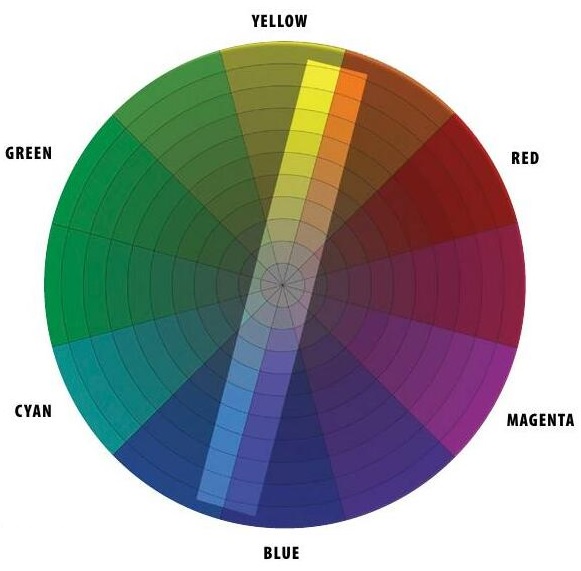Using Complementary Colors

WHAT ARE COMPLEMENTARY COLORS?
Two colors are called complementary when they have opposite or balanced color characteristics, such as blue vs. yellow-orange or green vs. red-violet. Complementary hues appear across from each other on the color wheel. When you mix two such pigments together, they make gray or black. Mixing two complementary sources of light yields white light. When you stare at one hue for an extended period of time, the afterimage that emerges is the complementary color. These oppositional pairs are related by their antagonism. One balances the other, like riders on a seesaw. They cancel each other out, but they also amplify each other when used together in a picture.
Let’s examine complementary relationships by doing some paintings composed entirely of the two colors in the complementary pair, and leaving out the rest of the hues. So in the color wheel here, we’ll only use the blue/orange colors inside the central rectangle, and we won’t have access to the greens and magentas. We’ll start by doing some experiments in the studio and then applying what we learn in a few demonstrations.
EXERCISE 1: TRAN-OPAQUE COMPLEMENTARY BLEND
Esta historia es de la edición Station Points de International Artist.
Comience su prueba gratuita de Magzter GOLD de 7 días para acceder a miles de historias premium seleccionadas y a más de 9,000 revistas y periódicos.
Ya eres suscriptor ? Conectar
Esta historia es de la edición Station Points de International Artist.
Comience su prueba gratuita de Magzter GOLD de 7 días para acceder a miles de historias premium seleccionadas y a más de 9,000 revistas y periódicos.
Ya eres suscriptor? Conectar

Step by Step: Capturing Expression
I painted Olivier as part of a demonstration for my Wednesday online class. The month's theme was \"Alla Prima Portrait Expressions,\" focusing on capturing dynamic emotion in a static image.

Intuitive response
My work is known for its raw, dynamic energy and freshness.

The Portrait Society of America Chairman's Letter Educate, Inspire, Connect
Ralph Waldo Emerson said, \"How much of human life is lost in waiting.\"

No Place Like Home
Focusing on color mixing and composition, Kayla Martell paints blissful interior scenes

Moved by Instinct
Inspired by the beauty of nature, Jean Haines' watercolors bloom with spontaneity

BACK-UP PLAN
An overview of the data storage options for all of the digital files that make up your art business

Apex Predators
Growing up in Kenya surrounded by nature, Guy Combes talks about the passions of painting wildlife

Skyscapes
Ksenya Verse highlights the intricate textures, variability and sculptural nature of clouds

Something beguiling
In watercolor, I work exclusively with transparent pigments, carefully building textural effects through multiple glazes (sometimes up to five or six layers) to achieve dimension and detail in my realistic watercolors.

HUNCHES ARE BUILT UPON WISDOM
Harley Brown's fascinating things no one else will tell you
